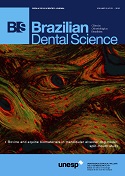Association of chlorhexidine and high fluoride dentifrice on Streptococcus mutans viability using an in vitro biofilm model
DOI:
https://doi.org/10.14295/bds.2016.v19i3.1258Resumen
Objective. This in vitro study investigated the effect of Fluoride (F), Chlorhexidine (CHX), and their association on the viability of Streptococcus mutans using a biofilm model. Materials and Methods. Biofilms were anaerobically grown on glass slides that were vertically suspended in 24-well plates for 5 days. After 48 h of initial growth, biofilms were treated for the next 72 h, 2x/day with CHX at 0.12% and 2%, F as NaF at 0.08% and 0.4% and their association. Results. CHX treatment decreased the bacteria counts either alone or in association with both F concentrations, when compared with control group and the F treatments alone (p<0.05). Conclusion. No addition effect was observed when CHX and F were used in combination, when compared with CHX used alone.
Descargas
Descargas
Publicado
Cómo citar
Número
Sección
Licencia
Brazilian Dental Science uses the Creative Commons (CC-BY 4.0) license, thus preserving the integrity of articles in an open access environment. The journal allows the author to retain publishing rights without restrictions.
=================
COPYRIGHT TRANSFER AND RESPONSIBILITY STATEMENT
(PDF)
For all articles published in the BDS journal, copyright is retained by the authors. Articles are licensed under an open-access Creative Commons CC BY 4.0 license, meaning that anyone may download and read the paper for free. In addition, the article may be reused and quoted, provided that the original published version is cited. These conditions allow for maximum use and exposure of the work while ensuring that the authors receive proper credit. All metadata associated with published articles is released under the Creative Commons CC0 Universal Public Domain Dedication.
Before the submission, authors must obtain permission to reproduce any published material (figures, schemes, tables, or any extract of a text) that does not fall into the public domain or for which they do not hold the copyright. Permission should be requested by the authors from the copyright holder (usually the Publisher, please refer to the imprint of the individual publications to identify the copyright holder).
The authors hereby attest that the study is original and does not present manipulated data, fraud, or plagiarism. All names listed made a significant scientific contribution to the study, are aware of the presented data, and agree with the final version of the manuscript. They assume complete responsibility for the ethical aspects of the study.
This text must be printed and signed by all authors. The scanned version should be submitted as supplemental file during the submission process.




























